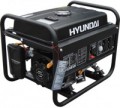Method of starting the electric generator engine. To start the internal combustion engine (petrol or diesel, see "Fuel"), it is necessary to turn the engine shaft in any case; this can be done in two ways:
—
Manual. With this method of starting, the initial impulse is transmitted to the engine manually - usually the user needs to pull hard on the cable that spins a special flywheel. The simplest in design and cheapest method of starting, from additional equipment it requires only the cable itself with a flywheel. On the other hand, it may require the user to apply significant muscular effort and is poorly suited for high-power units.
—
Electric starter. With this type of start, the engine shaft is rotated by a special electric motor, which is called a starter; the starter is powered by its own battery. This option for starting the generator power unit is the easiest for the user and requires a minimum of effort. Depending on the implementation of the electric starter, it is usually enough to turn the key in the ignition switch, press a button, turn the handle or rotate a special drum, etc. The power of modern starters is sufficient even for heavy engines, where manual starting is difficult or impossible. Also note that an electric starter is required by definition to use the ATS autostart (see "Features"). On the other hand, additional equipment affects the weight and cost of the unit,
...and sometimes quite noticeably. Therefore, such starting systems are used mainly where they cannot be avoided - in the aforementioned heavy equipment, as well as generators with ATS.The total weight of the unit - usually excluding fuel; the weight on full tank can be easily determined knowing the tank capacity.
In general, more powerful generators are inevitably heavier, but models with similar characteristics can differ significantly in weight. When assessing these differences and generally choosing an option based on weight, it is worth considering the specifics of the generator's use. So, if the device is often to be moved from place to place - for example, when used "on the road" - it may be worth paying attention to lighter units that are more convenient to transport. However, it is worth considering that the downside of a lightweight design is often an increased cost or a reduced degree of protection. But for stationary use, you can not pay special attention to this parameter - or even the opposite: choose a heavier (and, as a rule, more advanced and functional) option.
Regarding specific figures, it is worth noting that modern generators are generally quite massive. Thus, a small weight for such equipment is considered not only
< 20 kg, but even
20-30 kg ; many units weigh
150-200 kg, or even
more, and the weight of stationary industrial models is measured in tons.

